You want to offer your customers stylish, eco-friendly bamboo plates, but you’re haunted by headlines about harmful chemicals. The fear of choosing the wrong product, one that could damage your brand’s reputation or even harm your customers, is very real. It’s a confusing world of claims.
Yes, bamboo plates are safe for food, but only when they are manufactured correctly and certified. For reusable plates, this means they are made with bamboo fiber and a high-quality, food-grade binder like A5 melamine, and are certified by bodies like the FDA or LFGB. For disposable plates, it means they are 100% natural bamboo. Crucially, reusable bamboo-melamine plates should never be microwaved.
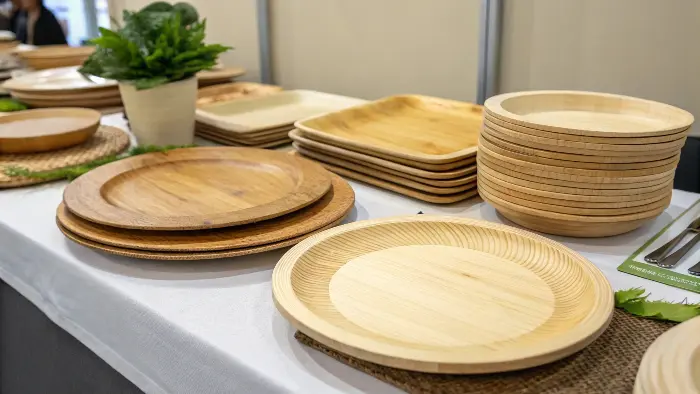
Choosing the right bamboo plate isn’t just about aesthetics or eco-friendliness; it’s about safety and trust. Understanding the difference between a high-quality, certified product and a cheap imitation is the most important decision you’ll make. Let’s break down exactly what you need to look for to source with confidence and protect your brand.
Is the bamboo material itself safe for food?
When you see the word "bamboo," you instantly think "natural" and "safe." But then a doubt creeps in. Is the raw material truly safe for a dinner plate, or are there hidden risks from processing? This uncertainty can make you hesitate on what seems like a perfect eco-friendly product.
Yes, the raw bamboo plant is inherently safe and non-toxic for food contact. Bamboo is a type of grass, not wood, and it even possesses natural antimicrobial properties. The safety questions arise not from the bamboo itself, but from the binders and adhesives used to press the bamboo fibers into a durable, reusable plate.
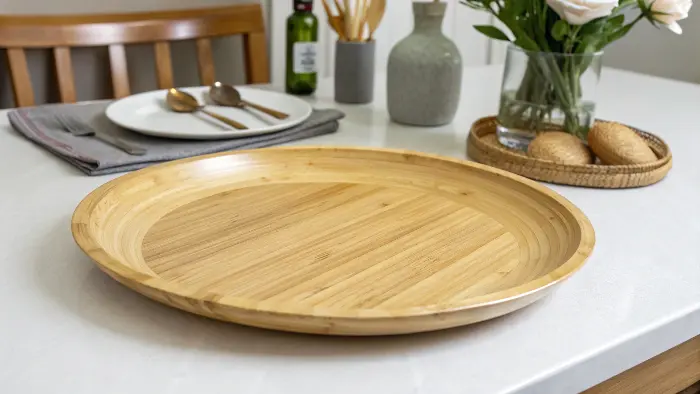
I’ve spent a lot of time with suppliers, and this is the first thing we always discuss. The bamboo itself is fantastic. It grows incredibly fast without needing pesticides or fertilizers, making it a wonderfully sustainable raw material. The critical part of the safety conversation begins when we talk about how that raw bamboo fiber is transformed into a finished product. This is where a buyer needs to pay close attention.
Two Main Types of Bamboo Plates
To understand safety, you first need to know that "bamboo plate" can refer to two very different products.
- 100% Bamboo Disposable Plates: These are typically made from the sheath of the bamboo plant. The sheaths are cleaned, boiled, and then pressed into shape using only heat and water. There are no binders, glues, or chemicals added. They are as natural as a leaf and are fully compostable.
- Reusable Bamboo Fiber Plates: These are the colorful, durable plates you see in retail stores. They are made by grinding bamboo into a fine powder. This powder is then mixed with a binder—usually food-grade melamine resin—to create a durable, long-lasting, and dishwasher-safe material.
The safety journey for each is completely different. For a buyer like Jacky, knowing this distinction is fundamental. He needs to know if he’s sourcing a single-use compostable item or a long-lasting reusable one.
Here’s a simple comparison:
| Feature | Disposable Bamboo Plates | Reusable Bamboo Fiber Plates |
|---|---|---|
| Composition | 100% Bamboo Sheath | Bamboo Fiber + Melamine Binder |
| Manufacturing | Heat and Water Pressing | Compression Molding with Resin |
| Primary Safety Concern | Cleanliness of raw material | Quality and stability of the binder |
| End-of-Life | Fully Compostable | General Waste (Not Biodegradable) |
| Best Use Case | Events, picnics, single-use settings | Daily home use, displacing plastic plates |
So, while the bamboo itself gets a green light, the real question for reusable plates is about the materials it’s mixed with.
What makes a reusable bamboo plate safe or unsafe?
You’ve likely heard the horror stories about melamine leaching from reusable bamboo plates into food. This fear is valid and can paralyze your sourcing decisions, making you stick with less eco-friendly options like glass or ceramic. You need to know what separates a safe plate from a dangerous one.
A reusable bamboo plate’s safety depends entirely on the quality of the melamine binder used. High-quality, food-grade melamine (known as A5) is stable and perfectly safe for serving cold and warm foods. The danger comes from low-quality, industrial-grade binders that can leach harmful chemicals, especially when exposed to high heat or acidic foods.
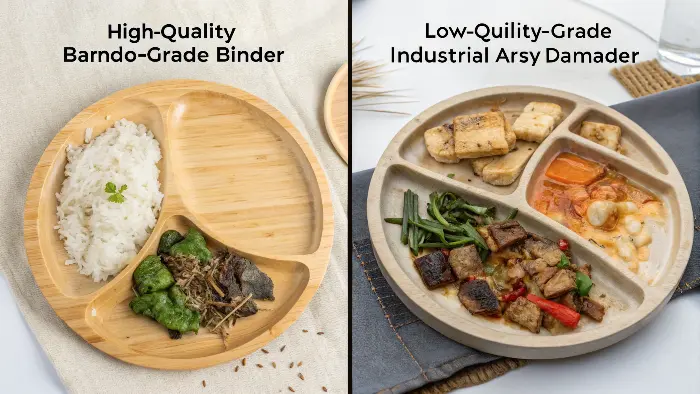
This is the part of my job where I become a detective. I don’t just take a supplier’s word for it; I demand to see the test reports. The difference between a safe product and an unsafe one is invisible to the naked eye, so third-party verification is the only thing that matters.
The Melamine Question
Melamine is a nitrogen-based compound used to create a thermosetting plastic, or resin. This resin is what gives reusable bamboo plates their durability and smooth finish.
- Food-Grade (A5) Melamine: This is a higher-purity resin designed for food contact. It’s stable and non-toxic under normal use conditions (i.e., serving food, not cooking in it).
- Industrial-Grade Melamine: This is cheaper and not designed for food safety. It can contain impurities and is more likely to break down and migrate into food.
The Critical Role of Heat and Certification
The single biggest risk factor is heat. You must never microwave a bamboo-melamine plate. High heat can cause the melamine resin, even the food-grade kind, to break down and leach into food. This is why clear user instructions are just as important as sourcing.
To ensure you’re getting a safe product, you must demand certifications:
- FDA (U.S. Food and Drug Administration): This certification ensures the product meets U.S. safety standards and that any migration of substances is well below harmful levels.
- LFGB (German Food, Commodity and Feed Law): This is the European standard and is often considered stricter than the FDA’s. An LFGB certification is the gold standard and signals a very high-quality product.
- BPA-Free: While the primary concern is melamine, ensuring the product is also free from Bisphenol-A is another layer of consumer protection.
Here is the checklist I use when evaluating a new supplier:
| Safety Checkpoint | Why It Matters | What to Ask Your Supplier |
|---|---|---|
| Binder Material Specification | Confirms they are using 100% food-grade (A5) melamine, not a cheaper blend. | "Can you provide the material spec sheet for the resin?" |
| Valid LFGB or FDA Test Report | Provides third-party proof that the finished product is safe for food contact. | "Please send a current LFGB test report from a reputable lab." |
| BPA-Free Declaration | Ensures another common chemical of concern is not present. | "Is this product certified BPA-Free?" |
| Clear Use & Care Instructions | Prevents misuse (like microwaving) that could make a safe product unsafe. | "What are the recommended care instructions for consumers?" |
Sourcing safe bamboo plates isn’t about luck; it’s about a rigorous, disciplined process.
How many times can you actually reuse bamboo plates?
You want to market your bamboo plates as a durable, long-lasting alternative to single-use plastic. But if they crack, stain, or fall apart after just a few uses, you’ll be dealing with angry customers and a damaged brand reputation. You need to set realistic expectations for durability.
High-quality, reusable bamboo plates made with a food-grade binder can be used for several years with proper care. They are generally top-rack dishwasher safe but must never be put in the microwave. Their lifespan depends on avoiding extreme temperatures, harsh abrasive scrubbing, and sharp knives, which can compromise the plate’s surface.
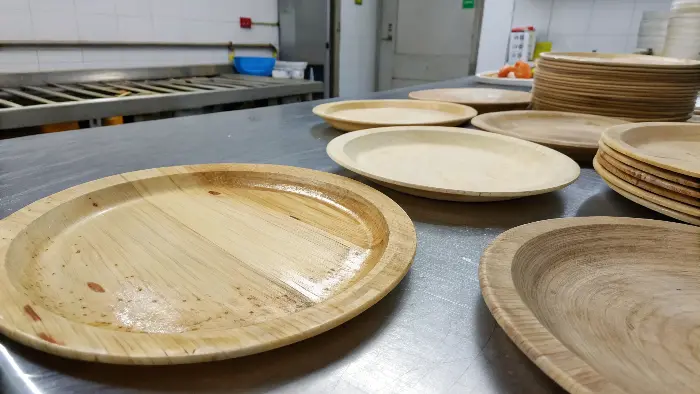
I always tell my partners to think of reusable bamboo plates like high-quality plastic or melamine dinnerware, but with an eco-friendly origin story. They are tough, but not indestructible. Their value comes from their longevity when treated correctly. A customer who understands this will be a happy, loyal customer.
Extending the Lifespan with Proper Care
The care instructions you provide are critical to customer satisfaction.
- Washing: While many are top-rack dishwasher safe, hand washing is always the gentlest option and will prolong the plate’s life. Avoid abrasive scourers that can scratch the surface.
- Temperature: This is the most important rule. They are perfect for hot foods like pasta or soup, but they should not be used for cooking. No microwave, no oven. This prevents the binder from breaking down.
- Cutting: Using sharp steak knives directly on the plate can scratch and damage the surface over time, just like with regular melamine plates.
- Staining: Very strong-colored foods like curries with turmeric or tomato-based sauces can cause slight staining over time. This is often a characteristic of natural-fiber-based products and doesn’t affect safety.
- Damage: If a plate is dropped and cracks, it should be discarded. Bacteria can grow in the cracks, making it unsanitary.
Here are the simple care instructions we recommend:
| Do’s | Don’ts |
|---|---|
| ✅ Wash in the top rack of the dishwasher | ❌ Never use in the microwave or oven |
| ✅ Use for hot and cold foods | ❌ Don’t use abrasive scouring pads |
| ✅ Hand wash for best results | ❌ Avoid using sharp, serrated knives |
| ✅ Dry thoroughly before storing | ❌ Don’t use if cracked or broken |
With this care, a set of reusable bamboo plates can easily last for 2-5 years of regular use, successfully displacing hundreds, if not thousands, of single-use plates.
What happens when you’re done with them? How long do bamboo plates take to decompose?
The "eco-friendly" promise can feel hollow if the product just ends up sitting in a landfill for centuries. You need to understand and communicate the true end-of-life story for your bamboo plates to maintain brand transparency and credibility.
The decomposition time for bamboo plates depends entirely on their type. Disposable plates made from 100% bamboo can biodegrade and compost in just 2 to 6 months. In contrast, reusable bamboo plates made with a melamine binder are not biodegradable or compostable and must be disposed of in general waste.
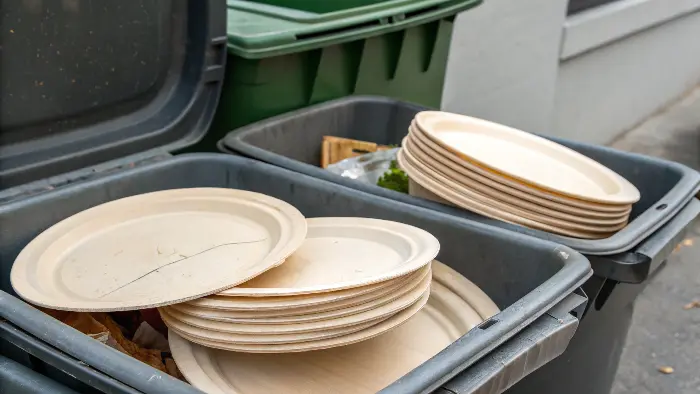
This is one of the most misunderstood aspects of bamboo tableware, and being honest about it is crucial for building trust, especially with knowledgeable buyers. The environmental benefit of each type of plate comes from a different place.
The End-of-Life Story: Two Different Paths
-
Disposable 100% Bamboo Plates: These are a true "circular" product. They come from the earth and return to it. In a commercial composting facility or even a well-managed home compost bin, they will break down into nutrient-rich soil. Their environmental win is their rapid, clean decomposition. Look for compostability certifications like BPI or TÜV Austria to verify these claims.
-
Reusable Bamboo-Melamine Plates: It is critical to be clear: these are not biodegradable. The melamine resin is a plastic that prevents the bamboo fiber from breaking down. Their environmental benefit comes from reuse and displacement. Over its multi-year lifespan, one reusable bamboo plate prevents hundreds of disposable plastic or paper plates from being made, used once, and thrown away. Its eco-friendliness lies in its durability and waste reduction, not its disposal.
This table clarifies the end-of-life for each:
| Feature | Disposable Bamboo Plates | Reusable Bamboo Fiber Plates |
|---|---|---|
| Composition | 100% Natural Bamboo | Bamboo Fiber + Melamine Resin (Plastic) |
| End-of-Life Option | Commercial or Home Composting | General Waste / Landfill |
| Decomposition Time | 2-6 Months | Not Biodegradable (Hundreds of years) |
| Environmental Win | Returns to the earth cleanly. | Reduces waste by displacing single-use items. |
Being transparent about this with your customers is not a weakness; it’s a strength. It shows you respect them, you understand your product’s full lifecycle, and you are an honest, trustworthy brand.
Conclusion
Bamboo plates can be a safe, stylish, and sustainable choice for your brand. The key is to source with diligence. For reusable plates, demand food-grade materials and verify them with FDA or LFGB certifications. For all types, educate your customers on proper use, care, and disposal to ensure safety and satisfaction.


